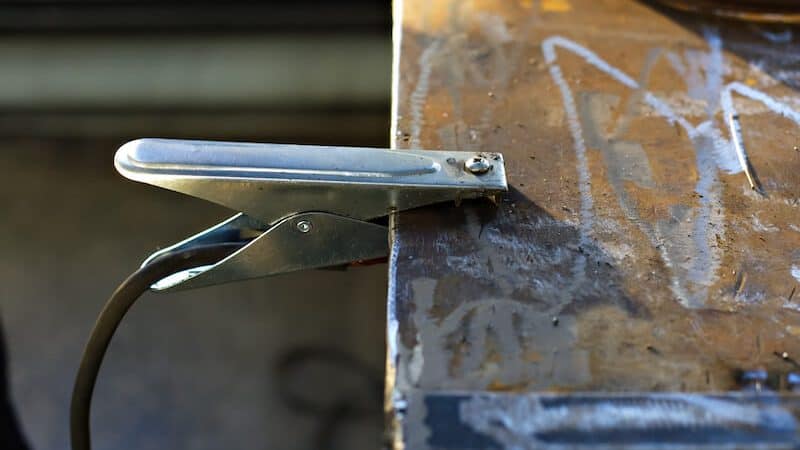To ground when welding, attach the welding machine’s ground clamp to a clean, unpainted metal surface on the workpiece or the workbench. Ensure a secure connection and avoid thin or sharp edges, which can cause resistance, overheating, or arc instability. Proper grounding ensures safety and weld quality.
This process is an integral part of the whole weld process. Therefore, the state of your grounding affects several important aspects of welding, including your safety and the overall quality of your products.
So, if you want to learn how to ground when welding, including the whys and hows of grounding, then keep reading.

Table of Contents
Why Do You Ground a Welder?
Your safety is one of the most important reasons for grounding your welding machine. Practicing correct grounding ensures that your working space is safe. This is why proper grounding, as a procedural practice, is a must in codes and standards.
Also, bad circuits result in bad welds. In other words, the weld’s quality depends on your circuit’s status.
So, to ensure consistency in the quality of your welds, you must always properly ground your tools.
What Does a Bad Ground Cause?
A bad ground is when your electrical circuit is incomplete or loose. This means that the path of your electrical current is unsecured, which could lead to potential accidents like electric shocks or electrocution.
A low-quality, poorly connected, or unmaintained clamp is typically the cause of bad grounding.
The current cannot safely pass through your clamp and onto the metal piece when this happens. This could damage your clamps, disrupting the circuit and, ultimately, ruin your work.
Bad grounding also has repercussions on the overall value of your work. One of them is that it significantly reduces your weld quality. Low weld quality compromises the build and stability of your workpiece.
How to Ground a Welder
Grounding your welding machine is easy. However, there are some important points that you need to keep in mind when grounding your equipment, such as the following:
- First, begin by inspecting your ground clamps for any damage.
- To ensure a stable circuit, make sure no debris or material could block the ground plates inside your clamp.
- Next, clean the part of your workpiece or weld table where you’ll attach your clamp.
- Once done, attach your clamp to the workpiece or your table.
- Finally, ensure your clamp is secure and not too far away from your weld points.
Different Types of Grounding
Whether you’re a professional welder or planning to be one, it’s not a bad idea to familiarize yourself with the various grounding techniques.
Take a look.
Double Insulation
Some machines use double-insulated cables. These devices are what you’d call a double-insulated appliance.
In other words, they don’t need to be grounded as they use reinforced protective insulation on top of their basic insulation. It’s specifically designed to function safely without connecting it to the ground.
Grounding Connectors
One of the most common types of grounding in welding apparatus is through grounding connectors. This type typically uses flexible cables to connect to a receptacle.
With the help of these cables, the whole system links the metal enclosure of your equipment to a metal rod buried in the ground.
High-Frequency Grounding
This type of grounding is common in gas tungsten arc weld machines. Welders often use this type to initiate and stabilize the electrical current through a high-voltage frequency.
However, one of its downsides is that high-frequency signals can travel away from your weld area. As a result, these signals can disrupt other electrical appliances, such as televisions.
Portable and Vehicle-Mounted Welding Generator Grounding
Grounding these types of equipment depends on a variety of factors. For example, if you mount your generator to a vehicle, you’re not required to ground it.
In certain situations, however, you must ground the generator, such as when it’s connected to other wiring systems.
Workpiece Grounding
Workpiece grounding is similar to grounding the enclosure of your equipment. In this case, you need to connect your workpiece or weld table to an appropriate ground.
In this type of grounding, the current flows through all the conductive materials from your machine all the way to your workpiece. This completes the circuit, effectively preventing electrical leaks and incidents.
Grounding Pins in Plugs
If your machine is on a smaller scale, it typically uses grounding pins in its plugs. It’s usually the third prong below the two parallel plugs.
These pins are also called grounding poles. They work by sending the extra current into the ground and away from your devices.
Conclusion
To quickly recap, grounding is when you complete an electrical circuit by connecting your ground clamps to the workpiece when welding.
Proper grounding is necessary to ensure your safety and improve the quality of your welds. For these reasons, you must maintain your machine, particularly your clamps.
There are various types of grounding for welding. This is why knowing why and how to ground when welding is one of the most important things you need to learn for your safety and the safety of your products.
